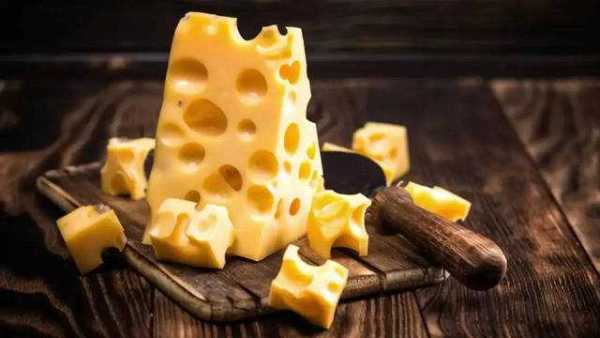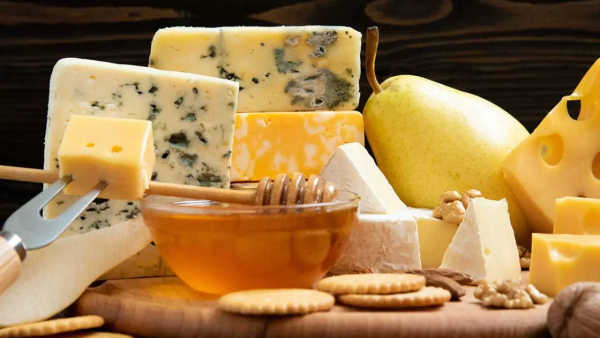
If you have to pick one guilty pleasure that you would gladly indulge in, it’s cheese. From classic recipes to comfort foods, cheese is a sinful indulgence that 8 out of 10 people wouldn’t do without. Whether it is mac & cheese or sandwiches, salads, or pizzas or pasta – cheese only elevates the experience of food when added. Cheese elevates culinary dishes not only with its flavour and texture, but also with its aroma and colour. And with an impressive nutritional profile, cheese offers protein, fat, calcium, phosphorus, potassium and vitamin B12—making it one of the important foods for a balanced diet.
However, cheese still often gets side-eyed for its high-fat content. People hence tend to compare between different types of cheese and then take their pick based on their priority.
Types of cheese:
Cheeses are categorised in many ways, including the type of milk, fat content, and ripening process. Here are some examples of different types of cheese:
Cheddar : A hard, high-fat cheese that is a cultured dairy product.
Mozzarella : An Italian cheese that is usually made from buffalo milk and is created using a spinning and cutting technique called ‘pasta filata’.
Feta: A white, brined cheese that is made from sheep's milk or a combination of sheep and goat's milk. It has a crumbly texture and a salty, tangy flavour.
Blue cheese: A general term for a wide range of cheeses made from any type of milk. Some classic blue cheeses include Roquefort, Gorgonzola, and Stilton.
 Gouda:
Gouda: A semi-hard, close-textured cheese with a washed rind. It is also known as sweetmilk cheese.
Ricotta: A soft, fresh whey cheese that can be made from the milk of sheep, cows, or goats.
Brie : A soft cheese with a chewy rind and a creamy flavor that originated in France. It goes well with fruits, cured ham, and wine.
Camembert: A soft cheese that originated in Normandy, France. It has an earthy, umami, and grassy taste and a thick, velvety, and sticky texture.
Cheddar cheese:
Cheddar cheese is a hard, smooth-textured cheese that originated in the English village of Cheddar. Cheddar cheese can be white, yellow, or orange, depending on whether colourings like annatto are added. Cheddar cheese is rich in protein and vitamin K2 and is often used in grilled cheese sandwiches. In the UK, it's usually pale yellow, while in the US it's orange-yellow. Cheddar cheese can range in flavour from mild to sharp, depending on how mature it is. The word ‘cheddar’ was first recorded between 1655 and 1665. It's named after the village of Cheddar in Somerset, England, where the cheese was first made. Cheddar is the most popular cheese in England and the second most popular in the US, after mozzarella.

Mozzarella cheese:
Mozzarella is a soft, white, semi-aged cheese that originated in Italy and is commonly used in pizza. Mozzarella is a fresh, moist cheese with a shiny, damp appearance and a smooth, rubbery texture. When cut, it releases a white, milky liquid. Mozzarella has a mild flavour. Mozzarella is made using the pasta filata, or ‘stretched-curd’, method, where the cheese mass is kneaded and stretched like bread dough. The word mozzarella comes from the Italian word mozzare, which means ‘to cut off’. Mozzarella is traditionally made from Italian water buffalo milk, but cow's milk is also commonly used. There are different types of mozzarella, including mozzarella, low-moisture mozzarella, and part-skim mozzarella. Fresh mozzarella should be eaten within a few days and kept in its packaging liquid. Shelf-stable ‘low-moisture’ mozzarella lasts longer and can be shredded.
Cheddar or Mozzarella?
Mozzarella and cheddar have numerous benefits. Both these types are widely manufactured, sold, and consumed across the world because they add a beautiful flavour and taste to any delicacy. Whether it is an adult or a kid, anyone would enjoy a good cheese spread in their food.
Whether cheddar or mozzarella is better depends on your dietary goals:
Calories and fat: Mozzarella is generally lower in calories and saturated fat than cheddar. Mozzarella is a good choice if you're trying to lose weight or watching your calorie intake.
Protein and vitamin K2: Cheddar is a good choice if you need more protein and vitamin K2. Vitamin K2 is important for heart health and may help prevent osteoporosis.
 Sodium:
Sodium: Mozzarella usually has less sodium than cheddar, which may be beneficial if you're concerned about high blood pressure.
Additives and preservatives: Fresh mozzarella is minimally processed and often contains fewer additives and preservatives.
Flavour: Cheddar is an aged cheese with a richer flavour, while mozzarella has a milky, grassy, and floral flavour with a hint of tang.
Texture: Cheddar is a semi-hard cheese, while mozzarella has a soft, moist texture.
Both cheddar and mozzarella are high in calcium, which is important for bone health. However, it's easy to overeat cheese, so moderation is key. A 1-ounce serving size for both cheeses is about the size of a small pair of dice.

 Gouda: A semi-hard, close-textured cheese with a washed rind. It is also known as sweetmilk cheese.
Gouda: A semi-hard, close-textured cheese with a washed rind. It is also known as sweetmilk cheese.

